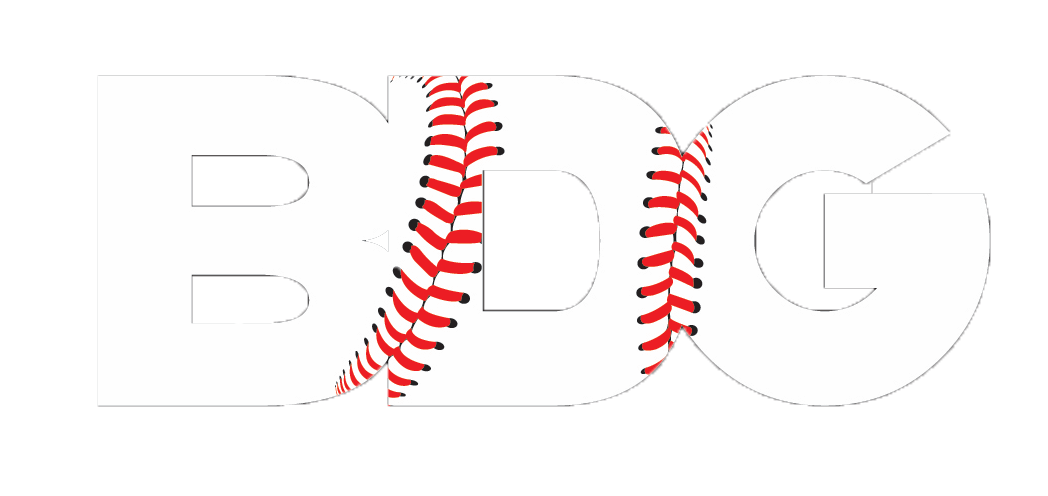INTRODUCTION TO PITCH DESIGN
A Free Guide for BDG Members
Everywhere you turn right now, you’re seeing two words follow you:
Spin Rate.
It’s all over social media, talked about on the national broadcast, and everyone knows it’s important.
But what does it actually mean? And what do we currently know about it?
On this page, you’re going to learn everything you need to know about spin rate and what it means for performance. Let’s go.

By now, I’m sure some of you have heard of Rapsodo and what it does. If you haven’t, you will soon. Rapsodo is one of the most important tools in terms of feedback for players and coaches regarding the movement profile of a pitch, whether that be a fastball, curveball, or anything else. To keep things simple, it’s a camera that can quantify spin, infer movement, and speed of a pitch, effectively allowing us to objectively measure how good our stuff is. Essentially, we can look at your fastball’s characteristics and rate it relative to what would constitute as good, poor, or otherwise.
Rapsodo is another great example of the adoption of technology in baseball. Last year, there were just a small handful of MLB organizations using these units in Spring Training. This year, that number has exploded to include every single one of them. Mike Petriello wrote a great article on the explosion of the Rapsodo (and other tech devices) in a recent post on MLB.com that you can find here.
The game is changing at the highest level, towards a more objective and analytical approach to measuring a pitchers stuff, and the effects will sprinkle down to the rest of baseball. Fortunately, we’re (slightly) ahead of the times at BDG, having now used the Rapsodo unit for just over a year. We were one of the lucky few early adopters and now carry some experience with it that we can employ with our athletes. We can confidently say that in using the Rapsodo appropriately and effectively, we are living in a time of unchartered waters as it relates to developing a better pitching repertoire.
In this document, we are going to discuss the basics of pitch characteristics, the functionality of the Rapsodo, and some other key concepts related to designing pitches. We don’t expect athletes to fully understand everything in here but we believe that it’s important for them to be exposed to it. It is my (Steve) belief that pitch design concepts will become normalized in college baseball within the new few years, if not sooner, and it is our job at BDG to prepare our players for that.
We’re going to be going through all the stuff that you need to understand the video above, how to make changes, and why that matters for your baseball careers. We want to put you on par with what some of the best MLB teams and powerhouse D1’s are teaching their players.
WHAT ARE WE TRYING TO ACCOMPLISH?
Build better pitches, duh! We are trying to quantify your pitches first and foremost and then make adjustments; whether that be to your pitches or how you use them. That means that we’re looking at all of the information that the Rapsodo spits out, using the high speed cameras to see how the ball is coming out of your hand, and then figuring out if we can improve those pitches.
Step 1 in our pursuit of pitch design is to understand the language and why a ball moves the way that it does.
Step 2 is to understand what a good pitch looks like in terms of these Rapsodo numbers. “What’s my fastball supposed to look like?” is a common question that needs to be addressed.
Step 3 is quantify what you got and then look at high speed video to see how the ball is coming out of your hand. This is what you’re going to receive in video form in your player dashboard.
Step 4 is to start making changes and track them over time!
Step 5 is to then try to take those awesome new pitches, understand where they’d be effectively located in a game scenario, and execute.
Step 1: Why Does a Ball Move?
A brief and overly simplistic primer
As a pitch moves its way towards home plate, there is only a short list of factors that can actually affect how it moves. This section has quite a bit of basic physics in it, which may seem a bit overwhelming if you’re not a science person, but I still think it’s important to try and understand. The diagrams look harder than they actually are.
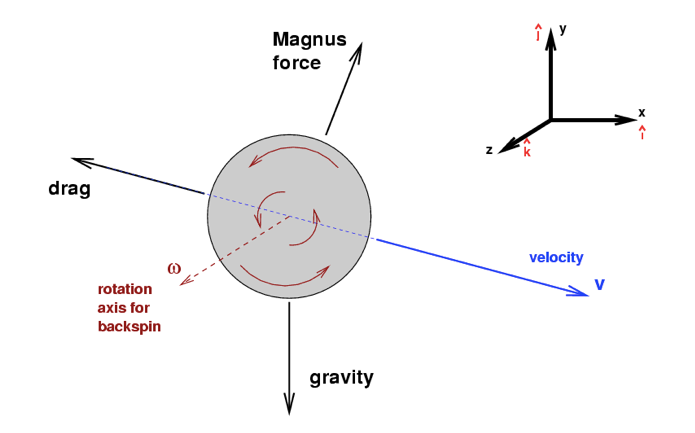
Let’s start with the simplest scenario possible.
If we removed all of the air from a stadium and then threw a ball that didn’t spin, then there would be only one force acting on the ball as it leaves the pitchers hand — gravity.
If we were to throw that baseball towards homeplate, without the force of air or rotation, gravity would exert it’s will on the ball and push it down towards the ground.

We know that gravity pulls us to the ground, so we would expect the ball to drop. Moreover, the ball would actually pick up velocity as it goes towards homeplate because it wouldn’t meet any other resistance.
But we know in real life that’s simply not the case. Baseballs slow down as the travel longer distances. Picture playing long toss with a teammate and how slow the ball lands in your glove. Even if your throwing partner unleashed a 100 MPH laser, by the time it reached you a few hundred feet away, it would be travelling at a much, much lower speed.
KEY POINT: A ball that moves through air has to ‘push’ air out of the way as it travels towards the plate. Because of Newton’s third law (for every interaction, there is an equal and opposite reaction) the air will exert a force back onto the baseball. This force is referred to as drag.
Drag slows objects down — just think of how NASCAR drivers and cyclers try to eliminate it by staying tightly in line behind their competitors (or wear skin-tight clothing).
The direction of the drag force will always be opposite to the velocity vector of the baseball. Meaning, if a ball is travelling directly towards home, the drag force will be directly towards centerfield.
The amount of drag exerted on the ball is a bit more complicated, being influenced by the speed of the ball and the spin.
But for now, you just need to know that:
1. Drag exerts a force opposite to the velocity of the ball and,
2. Gravity will pull the ball down
So far, so good?
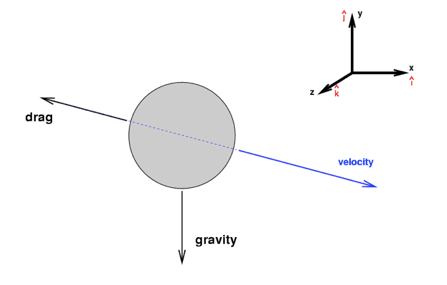
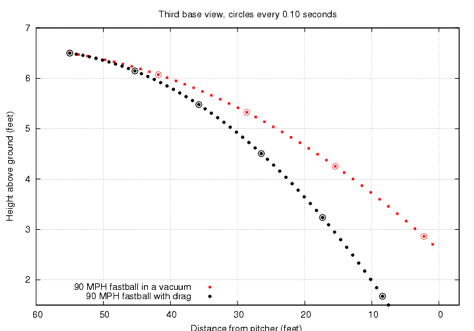
If you look at the image on the right, you’ll see two 90 MPH fastballs as viewed from third base. Both baseballs aren’t spinning. One of the baseballs is thrown without any air in the stadium (red) and the other is thrown with air (black). You’ll notice that the baseball interacting with air drops more — this is because it loses speed! The image on the right just shows the three factors affecting ball movement; velocity, drag in opposite direction to velocity, and gravity pushing straight down.
And now for the difficult part, factoring in spin.
Intuitively, we know that adding spin to a ball will do something to its movement. We know that a knuckleball kinda just floats through space, that adding a lot of topspin on a curveball makes it drop faster, and getting a lot of backspin on a fly ball makes it stay in the air longer.
A spinning object moving through air, will experience an additional force, due to the interaction of its surface and the air: one portion of it will be rotating WITH the air, while another portion will be rotating AGAINST the air. *Check the image and explanation below*
The portion that is rotating with the air will speed it up (they add to each other).
The portion that is rotating against the air will slow it down (they are working against each other).
These two different air speeds will create two different air pressures. Air travelling faster creates a lower pressure environment and air travelling more slowly will create a higher pressure environment.

This image will help explain things. Consider that the green ball is moving towards the right, meaning that the air will be exerting force towards the left (hence the arrows pointing to the left).
In this example, the ball has top spin like a curveball.
If you look at the top of the ball, the arrow of spin is going in the opposite direction of the arrow for air, meaning they are working against each other. The resultant air speed will be slower and the pressure will be HIGHER.
If you look at the bottom of the ball, the arrow of spin will be in the same direction as the arrow for air, meaning that they are working with each other. The resultant air speed will be faster and the pressure will be LOWER.
Therefore:
- The air moving around the bottom of the ball is faster and deflects the air upwards behind the moving ball. Look at how the arrows bend behind the bottom of the ball.
- Newton’s third law means that an opposite force to this upward deflection will be exerted back onto the ball — what’s called a Magnus force.
- In this example, the force from air is upward deflection meaning the Magnus force will be DOWNWARDS and therefore adding a dropping force!
This will make more sense if you consider that this picture is a top spinning ball moving to the right — or put more easily digestible baseball terms, you’re looking at a curveball being thrown from the perspective of third base. A pitch with pure topspin heading towards homeplate, aka a curveball, creates a downward moving pitch.
If you think about it the other way now, if you had pure backspin on that ball above, the arrows on the top of the ball would align creating faster air and lower pressure. The arrows on the bottom of the baseball would be going in opposite directions creating slower air and higher pressure. The faster air (on top) would deflect air downwards and thus create a Magnus force pushing the ball upwards!
The rule: The difference in air pressure between two sides of the baseball will create a force that greatly affects movement of the baseball. The baseball will move towards LOW PRESSURE.
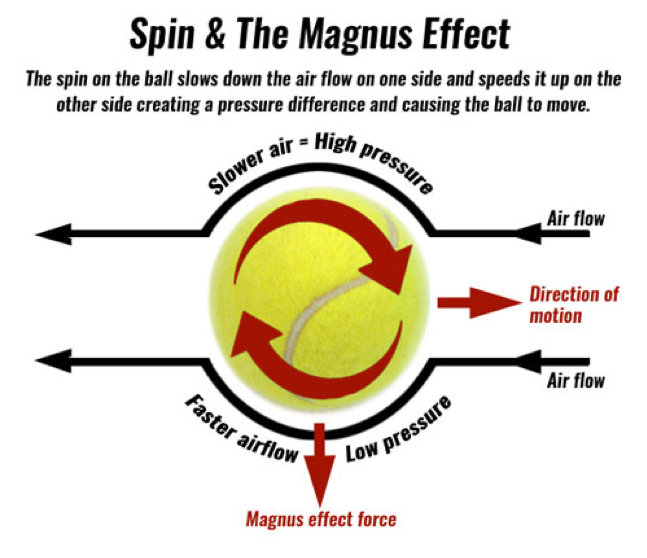
This image will help explain things. Consider that the green ball is moving towards the right, meaning that the air will be exerting force towards the left (hence the arrows pointing to the left).
In this example, the ball has top spin like a curveball.
If you look at the top of the ball, the arrow of spin is going in the opposite direction of the arrow for air, meaning they are working against each other. The resultant air speed will be slower and the pressure will be HIGHER.
If you look at the bottom of the ball, the arrow of spin will be in the same direction as the arrow for air, meaning that they are working with each other. The resultant air speed will be faster and the pressure will be LOWER.
Therefore:
- The air moving around the bottom of the ball is faster and deflects the air upwards behind the moving ball. Look at how the arrows bend behind the bottom of the ball.
- Newton’s third law means that an opposite force to this upward deflection will be exerted back onto the ball — what’s called a Magnus force.
- In this example, the force from air is upward deflection meaning the Magnus force will be DOWNWARDS and therefore adding a dropping force!
This will make more sense if you consider that this picture is a top spinning ball moving to the right — or put more easily digestible baseball terms, you’re looking at a curveball being thrown from the perspective of third base. A pitch with pure topspin heading towards homeplate, aka a curveball, creates a downward moving pitch.
If you think about it the other way now, if you had pure backspin on that ball above, the arrows on the top of the ball would align creating faster air and lower pressure. The arrows on the bottom of the baseball would be going in opposite directions creating slower air and higher pressure. The faster air (on top) would deflect air downwards and thus create a Magnus force pushing the ball upwards!
The rule: The difference in air pressure between two sides of the baseball will create a force that greatly affects movement of the baseball. The baseball will move towards LOW PRESSURE.
Let’s just let Rod Cross, one of the world leaders in the stuff, explain instead.
If we now head back to the first diagram showing all of the properties on ball movement, things should (hopefully) seem much less confusing! In this example, the baseball is moving to the right with backspin. Drag is going in the opposite direction (slowing it down) and gravity is pulling it downwards. The Magnus force is upwards and therefore it will resist drop.

Unfortunately, we’ve only just described the movement on a baseball that is spinning purely top or backspin towards the plate; either ‘rising’ (resisting drop) or dropping. These pitches have zero horizontal movement even though we know that pitches can break left or right.
So how does that work?
This all comes down tilting the axis of spin – a wee bit complicated but something that we can break down into parts.
Let’s first start with the previously mentioned pitches, ones that are either pure topspin or backspin; a true 12-6 curveball or pure four seam fastball. We will need to look at a new diagram, one that takes the vantage point behind the pitcher or looking in from centerfield.
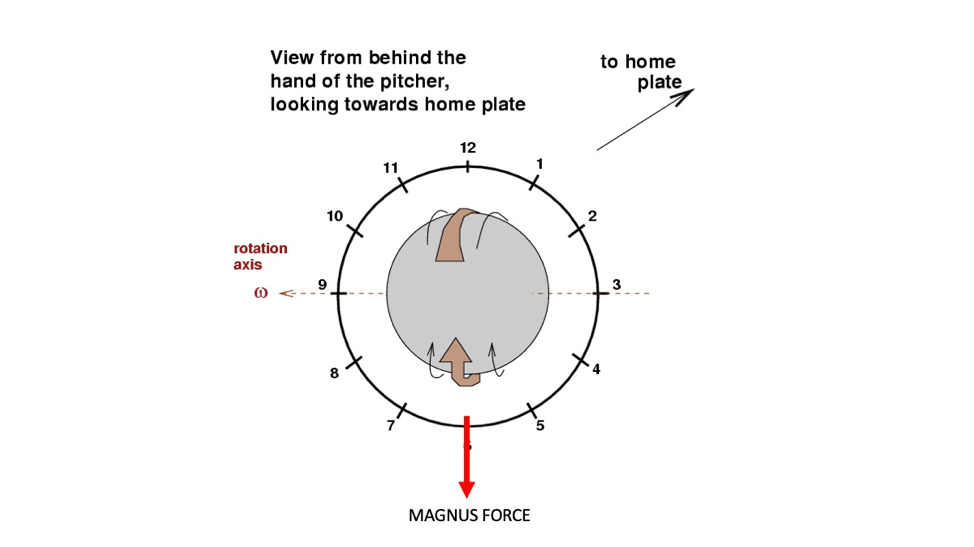
There’s a clock drawn around the baseball to help with the language about to be used. This diagram is of a pitch that has topspin (curveball) that is oriented straight up and down — or in other words, a true 12 to 6 curveball. Reminder: topspin in this case creates faster air speed under the ball (spin going in the direction air) that will create a deflection of air upwards. This upwards deflection is met with an opposite downwards force on the ball called the Magnus Force. Downward Magnus = drop.
On the Rapsodo, this clock value will be called Spin Direction. A true 12-6 curveball will have a spin direction of 6:00 and a true over the top fastball will have a spin direction of 0:00 (or 12 o’clock).
The axis of rotation (⍵) — the part of the ball that spin is oriented around — is always at a 90-degree angle to the spin direction. In this specific case, with a curveball, the axis of rotation is at 9 o’clock. On a pure backspin pitch, however, the axis of spin will be 3 o’clock.
If we were to tilt our hand, like in a ¾ thrower, then we’d expect our fastball and curveball to also break laterally. Intuitively, we know that! Let’s look at a diagram of a RHP throwing this curveball.

As you can see, the spin is no longer 12 to 6, but instead 1 to 7 (this is a curveball with topspin). In Rapsodo terms, the Spin Direction is 7:00. The axis of rotation (⍵) has shifted from a 9 o’clock position to a 10 o’clock position creating a Magnus force that is no longer straight downwards. It is now shifted slightly to the left (or first base side). Remember then, that the ball will move according to the Magnus Force.
Therefore, the resultant break on this pitch would be downwards and to the left as it approaches home plate.
Now what about a tilted fastball for a RHP? Try and think about it before looking at the diagram.
The baseball would be spinning with backspin with the axis tilted slightly to the right just like the curveball. As a result, the Magnus force would no longer be pointing straight up, but it would also be shifted to the…right!
Meaning, the baseball would have some upward force (resisting drop) and horizontal movement to the right. Exactly what you’d expect.
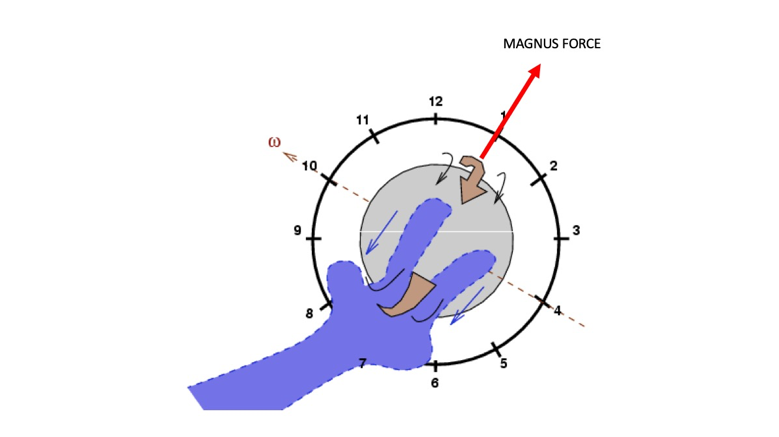
The axis of rotation went from a 3 o’clock position to a 4 o’clock position. The spin direction on the Rapsodo unit will now read 1:00. And the movement profile will be upwards and to the right.
Dissecting Spin
Up until this point, we’ve talked about pitches with a spin axis perpendicular to home plate. The pitches that were described so far would come off the hand directly behind the baseball. But in real life, that is not exactly how every pitch comes out of the hand.
Check out the two videos below to see the difference between staying behind the baseball and getting around it with your fingers.
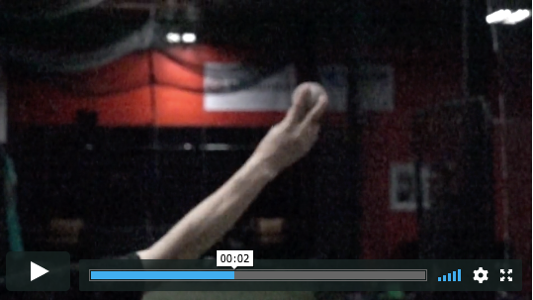

In some instances, the fingers get around the baseball rather than directly behind it, creating a spin that is slightly off-centre (the video on the right). If we think about it from the perspective of a fastball, rather than being directly behind the baseball on the left, our fingers come around the ball on release and ‘cut’ it. The spin has been altered.
The difference, however, will not necessarily create a difference in spin direction, but instead spin axis. We know that when the hand is directly behind the baseball, that the axis of rotation will be perpendicular to homeplate. In the picture below, the arrow points directly to the side. As we start getting our fingers around the ball, that axis starts migrating towards the catcher.
The video above helps demonstrate how the spin axis shifting will result in different break. Initially the ball is spinning purely on backspin, like a perfect fastball. As a result, all of the spin is contributing to upward break (or a less drop on the ball). As we start ‘cutting’ the baseball and shifting the spin axis into the wall, or computer screen, the amount of break contributing to upward lift starts declining… until there’s eventually none!
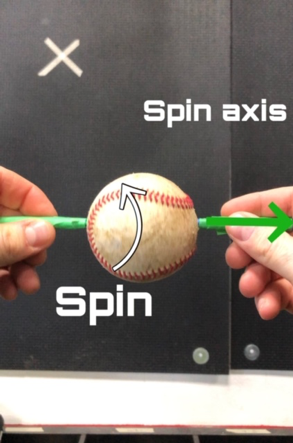
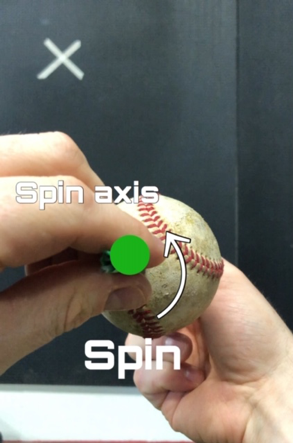
In the picture on the right, we are visualizing a curveball going directly into the page (or the black pad in the picture). The white arrow shows that it has top spin – so think of it as a curveball. When there is no ‘cut’, so pure top spin on the left image, the spin axis will be directly to the side (the green arrow). The spin axis is perpendicular to the direction the ball is travelling! As we add ‘cut’ to the baseball, the spin axis will start shifting towards where the ball is travelling. This is indicated by the green dot in the picture on the right.
Conceptually, think of the ball on the right image as spinning like a bullet out of a riffle.
There is a specific name for this type of spin — gyro spin.
Dr. Alan Nathan, one of the pioneers in applying physics to baseball, studied gyro spin extensively and found something interesting. When we’re accounting for spin & movement, there are actually two types of spin on a ball; gyro spin and transverse spin. Transverse spin being spin with an axis that is perpendicular towards the target (the left picture). Gyro spin, is spin with a spin axis that is parallel to the target (the picture on the right).
RULE:
Transverse spin (also called true spin) contributes to movement of the ball.
Gyro spin (spin that is tilted on an axis towards the plate) does not contribute to movement of the ball.
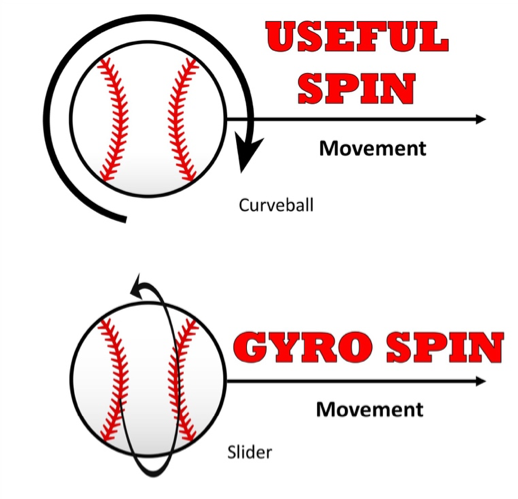
A pure 12-6 curveball has 100% topspin. We know that pure topspin has an axis of rotation that is perpendicular to the target. Therefore, all of that spin is classified as transverse spin and contributes to the movement of the ball.
A pure gyro ball has 100% gyro spin. All of that spin does not contribute to movement. The ball won’t move (much…it gets trickier than this).
A pure fastball, where the fingers stay behind the baseball, will have 100% transverse spin. This is regardless of whether the spin direction is 12-6, 1-7, 3-9, etc. (hammer this point home in your head because it’s important).
Somewhere in the middle
As you’ll begin to notice with your own pitches, as well as what’s spit out on the Rapsodo metrics, not all pitches are going to be 100% gyro or 100% transverse. Every pitch will have a combination of both of these types of spins. But not every pitch requires the same amount.
When we look at the Rapsodo metric “spin efficiency”, we are getting a number that represents the percentage of the total spin that is transverse. If a pitch has a total spin of 1000 RPM and 990 of it is transverse (99% is pure backspin), then the spin efficiency will be 99%. Or, to look at it differently, we created 1% gyro spin.
In other words — 99% of the spin on the baseball will contribute to movement!
As we get into the next part, it is important to keep this in mind. Just because someone has the highest spin rate on their fastball doesn’t necessarily mean it will have the most movement. Things aren’t that simple.
- Gravity pulls the ball downwards. If there’s 2500 RPM transverse backspin, it will fight gravity really well. If there’s 2000 RPM transverse spin, it will fall more (this is a sinker – great article here).
- Gyro spin doesn’t contribute to movement. But a pure gyro spin will actually shift its axis as it works towards the plate because of gravity (great article here).
It is important to keep this in mind. As you’re about to learn, Marco Estrada has an effective fastball even though it’s well below league average velocity because of it’s high spin rate.
Step 2: What Makes a Good Pitch?
A Basic Introduction

Now that we’ve got some of the vocabulary and physics down, it’s time to understand what we’re working towards. First thing is first, however, so let’s take a tour of the Rapsodo – what numbers it spits out, the graphs and visuals, and what they all mean. We must become familiar with the terminology.
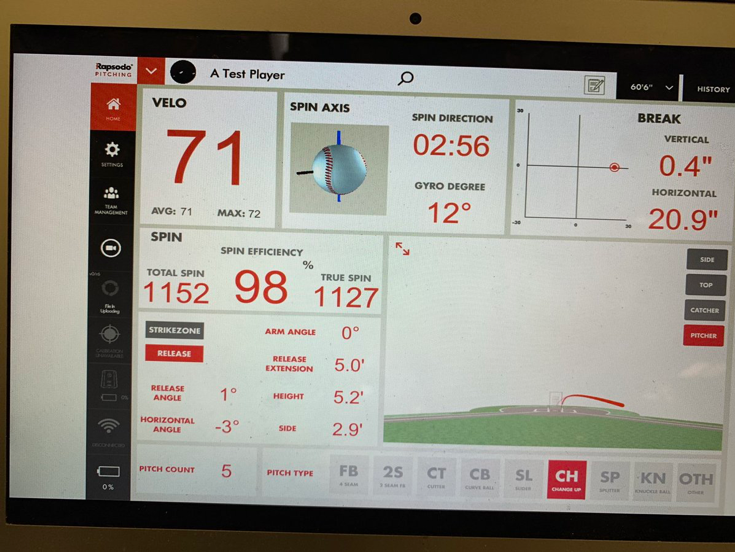
Let’s break down the numbers that are important to us.
Velocity: velocity measurement of the pitch described to the first decimal. Generally, we’ve seen the Rapsodo numbers to be either slightly higher or slightly lower than our Stalker radar gun. It appears to be slightly different for different guys – something other facility owners have also corroborated.
Total Spin: the total spin on the baseball in RPM (rotations per minute). Remember, total spin can be broken down into two separate components; gyro and transverse spin.
True Spin: this is the total transverse spin on the baseball in RPM. Remember, transverse spin is the type of spin that contributes to movement.
Spin Efficiency: total percentage of total spin that is true (transverse) spin. In other words, if a baseball has 1000 spin and 999 of it is true spin, then spin efficiency will be 99%.
Spin Direction: If we look straight on from the outfield at how a pitch is spinning, this will be equivalent to the position on a clock. A true over the top fastball will have a spin direction of 12 o’clock. Not to be confused with spin axis.
Gyro Degree: How many degrees of gyro spin is added to the baseball. If a pitch has 90 degrees of gyro spin, 100% of its spin rate will be composed of gyro spin. Remember, gyro spin doesn’t contribute to movement.

Horizontal & Vertical Break (inch): The diagram tells us how much horizontal and vertical break each pitch has. It can either be positive or negative. A positive vertical break is upwards; negative break is downwards. A positive horizontal break is towards the throwing arm; a negative break is towards the glove side.

Finally, it will also give you a catcher’s view point of where the pitch went through the strike zone (or not) and the path that it took to get there. This is more useful when we’re measuring command with our bullpens.
What we will do with this information, then, is to effectively quantify your arsenal. We answer questions like; how much movement do you have? How much spin do you have and what percentage is true versus gyro? What are the movement profiles to your pitches and what kind of separation do you have with them?
There’s a lot of depth that can go into this, so for now we’ll just keep things as simple as possible!
FASTBALLS
Generally speaking, we want our fastballs to have as much ‘true spin’ as possible – to aid in creating movement. Regardless of whether we are throwing a two seam or four seam, we want to keep the spin efficiency number above 80%, while shooting for 90+%. This is not a hard and fast rule, but more of a general statement.
Things get tricky when we are talking about the difference between four and two seamers, as the seams themselves play a complex role. To keep things simple, if we release a two seam and four seam fastball with the same spin axis, we are going to get very similar pitches.
In most cases, players think that their two seam moves more laterally and their four-seam goes more vertically. In reality, they are usually the same pitch because they are thrown with the same spin axis.
Remember, if we want a baseball to break more laterally, we are going to want to create a more vertical spin axis, or a spin direction that is closer to 3 o’clock (RHP) or 9 o’clock (LHP). If we want to create less drop on the baseball (or more vertical force pushing the baseball upwards) we will want pure backspin and a spin direction closer to 12 o’clock.

If the spin direction is closer to the 12 position, then it will exhibit more vertical break. If it’s closer to the 3 position, it will exhibit more lateral break. This is for a RHP.
So whether a player is holding a four seam or two seam grip, if they are throwing the baseball with near perfect backspin at a 12-6 spin direction, there will be much less lateral movement!
What we do pay more attention to in young pitchers is how much gyro component there is on their fastball; how much they cut it. What we’ll often see is a spin efficiency that is below 80%, creating lateral break in the opposite direction (towards the glove), as well as lowered velocity. This isn’t a problem when we’re trying to do it on purpose but if our goal is for a true fastball then this isn’t an ideal situation.

Here’s a good visual of one of our players getting his fingers ‘around the ball’ as exhibited on our high speed cameras. This player will create more movement to the glove side with a lower velocity.
How does this fit into recovery days?
